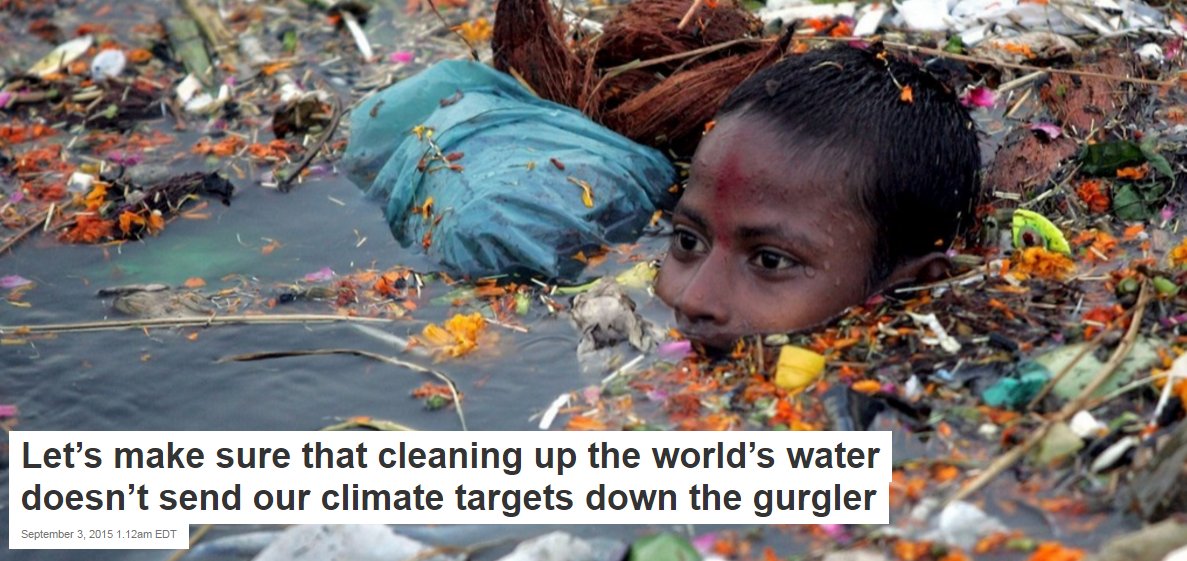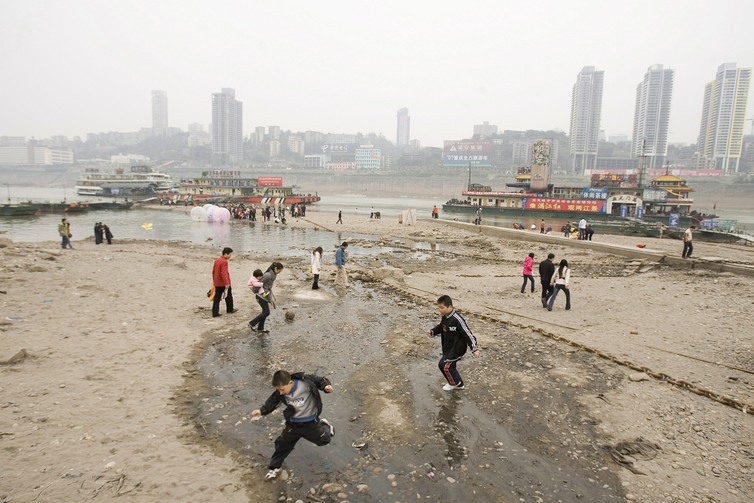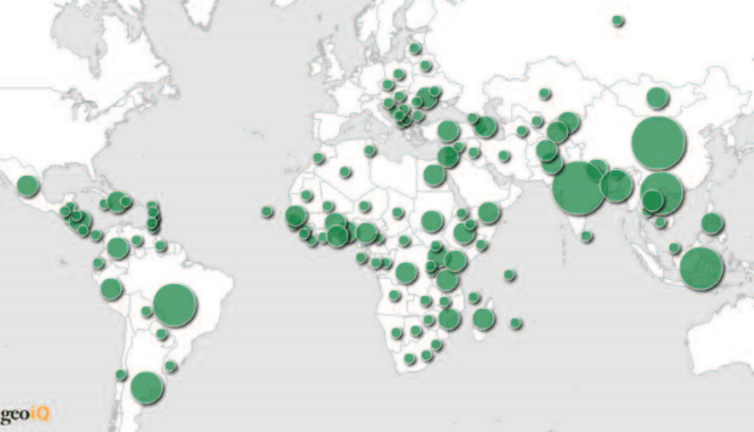
Date: 2024-04-28 Page is: DBtxt003.php txt00012460
Issue
Clean water and sanitation / Climate impact
Let’s make sure that cleaning up the world’s water doesn’t send our climate targets down the gurgler
Burgess COMMENTARY
Comment 161218 ... This article is typical in that it tries to summarize complex requirements in a simplistic way ... in a way that is 'either or' rather than being a best balance of both. This is part of the reason why I have been wanting to see a system of metrics that give the appropriate weight to all the factors and the associated metrics. The idea that we should not have safe water is unacceptable ... and yes it does cost in carbon pollution to do large scale infrastructure ... and this is a reality. Rather we should be asking the question about why we tolerate vast amounts of inefficiency and waste when it is profitable for corporations, but don't do things that are no more anti-climate even though they deliver a whole lot of good to people and society at large!
Peter Burgess
Let’s make sure that cleaning up the world’s water doesn’t send our climate targets down the gurgler

New Delhi’s Yamuna River, like much of India’s water, is polluted. The world urgently needs low-carbon ways to clean things up. EPA/Harish Tyagi
Much of the world still lacks clean, safe water. Progress on sanitation is falling far short of the United Nations’ Millennium Development Goals. The scale of the problem is highlighted by India, where half the population – some 665 million people – still defecate in the open, and where most sewage, even from toilets, is dumped untreated into rivers and streams. Worldwide, contaminated water is implicated in 85% of all illness.
An even more pernicious problem with the world’s water is widespread contamination with antibiotics, fuelling the rise of resistant superbugs. A recent survey in China, for instance, estimated that 53,800 tons of waste drugs are entering the environment each year, even after wastewater treatment. Meanwhile paraben, an antimicrobial preservative used in cosmetics, food and medicines, has now been detected in Indian sewage treatment plants, and antimicrobial resistance is now seen as an increasingly serious threat to global public health.
Clearly, the world’s water is in urgent need of a cleanup. Installing or upgrading sewer networks and sewage treatment plants, and implementing regulations to curb the release of antimicrobials into waterways, will be crucial. But if we’re not careful, all this extra infrastructure will mean lots of extra greenhouse emissions.
Bad to worse
The pollution problem is most acute in China, where traditional smokestack industries have been joined by a new breed of technologies such as (ironically enough) solar panel manufacture, which produces highly toxic silicon tetrachloride.
A 2012 survey of 11 cities showed that 64% of water sources were severely polluted and 33% moderately polluted. The China Geological Survey has since reported that 90% of the country’s groundwater is polluted, 60% of it “severely”. Heavy metals such as cadmium, mercury, arsenic, lead, chromium, zinc, nickel and other contaminants like DDT are long-lived and can’t easily be “cleaned up” especially if they’re lodged in groundwater.
Add to that the legacy of pollution from years of open defecation; crude, poorly maintained or underused sewage works; oil runoff from roads; phosphorus, zinc, lead and nitrates; factory discharges; fertiliser and dung; pesticides and herbicides, and waste animal drugs from farms.

Many Chinese waterways are severely polluted. EPA/DIEGO AZUBEL/AAP
India is hardly better off, with a recent report finding that 80% of sewage flows untreated directly into its rivers, while thousands of small factories also discharge untreated sewage and toxic waste. These problems are exacerbated by extremely high populations and population densities – India is expected to have 404 million more city dwellers by 2050.
But it’s not purely a problem for the world’s Asian population epicentres. In Latin America and the Caribbean less than half of water is treated to secondary standard, and in Africa far less even than that.

The largest circles show the countries most in need of sanitation. World Bank
The emissions problem
But what will be the knock-on effects of rolling out new sewage treatment plants right across the world? We can get a feel for what is at stake by looking at the United States, where water sector energy usage rose by 74% between 1996 and 2013, largely as a result of the mandated installation of advanced water treatment systems under the Clean Water and Safe Drinking Water Acts.
Given the huge scale of retrofit needed for Asia, Latin America and Africa (currently home to 2 billion people without toilets), a vast amount of energy would be required to plumb buildings, install sewers in towns, and operate newly installed or upgraded sewage works.
Then, if we want to move beyond basic sanitation and into the issue of waste drugs and other bioactive chemicals, much more technology will be needed: activated sludge, trickling filters, membrane filtration, chemical treatments, ultraviolet irradiation, membrane filtration, reverse osmosis. Any and all of these make it hard to stay carbon-neutral.
Yet the carbon footprint of the water cycle can be vastly improved, by improving the maintenance and efficiency of treatment plants, and by using technology such as biogas for electricity generation. Moreover, the large number of flat surfaces – roofs, yards, etc. – found at sewage works makes them well suited for solar panels and even mini wind turbines. Coupled with new battery storage technologies and micro-grids, it’s clear that new sewage works in developing countries can start with a “clean sheet” in terms of using green energy.
China certainly has the capacity to build low(er) carbon water treatment infrastructure, despite its failure to meet and enforce environmental standards as a result of its previous use of underengineered sewage plants that were overwhelmed by sheer volume.
India is in a similar position, but financing sewage collection and treatment in its thousands of underperforming towns is a major challenge, and existing clean-up campaigns have not always focused enough on water quality.
Most developing countries share the same broad problem: the rapid modernisation and growth of their cities is overwhelming the human and natural capacity for pollution control. The poorest nations have no resources at all for moving away from pit latrines to install proper sewage and treatment infrastructure, and without these the sanitation goals of development agencies such as UNICEF will remain elusive. While people in these areas are rapidly being given access to mobile telecommunications technology, this zeal tends to go missing when it comes to fixing their crippling soil and water pollution problems.
Possibilities for Paris
One option is for delegates to the Paris climate talks to examine financing for sewage-treatment technologies that are designed to be carbon-neutral, and powered by combinations of renewable energy, battery storage technologies and micro-grids.
The West surely has more than a passing interest in helping to ensure that India and China take action – not least because these are the places where rich nations “offshore” their pollution, but also because these countries have become prime breeding grounds for the global spread of drug-resistant bacterial strains.
What’s needed in Paris this December is joined-up thinking about two of the most pressing issues affecting life and ecosystems on this planet: the health of our climate and the healthiness of our water.
Disclosure statement Peter Fisher does not work for, consult, own shares in or receive funding from any company or organization that would benefit from this article, and has disclosed no relevant affiliations beyond the academic appointment above. Partners RMIT University Victoria State Government RMIT University and Victoria State Government provide funding as strategic partners of The Conversation AU. View all partners Republish this article Republish Republish our articles for free, online or in print, under Creative Commons licence.